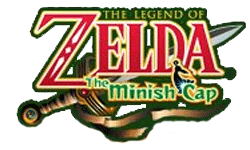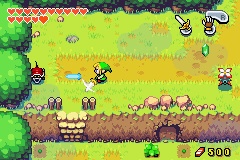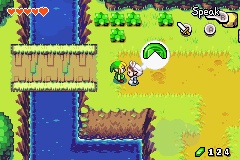|
|

|
BATTLE SYSTEM
|

|
INTERACTION
|

|
ORIGINALITY
|

|
STORY
|

|
MUSIC & SOUND
|

|
VISUALS
|

|
CHALLENGE
|
Easy
|
COMPLETION TIME
|
10-20 Hours
|
|
OVERALL
3.5/5.0
|
Rating definitions
|
|
|
The appearance of the Oracle titles on the Gameboy Color seemed to signal the end of the era of 2-D Zelda back in 2001; indeed, during the Gameboy Advance's lifespan for a few years afterward, no 2-D Zelda appeared on the system aside from a port of A Link to the Past. However, in 2004, Nintendo, with a little help from Capcom studio Flagship, which worked on the Oracle titles, developed, you guessed it, a 2-D Zelda, The Legend of Zelda: The Minish Cap, which saw release in Japan and Europe in 2004 and in America in 2005. While The Minish Cap unfortunately shares the curse of a neglected story with its predecessors, it's still an enjoyable game, and perhaps one of the strongest action RPGs of the current generation of titles.
Being 2-D, The Minish Cap naturally hails back to a time in action RPGs where players didn't have to worry about the camera constantly biting them in the ass, with a nice overhead perspective for fighting. Link, as usual, has his sword and shield, with the former able to dish out quick blows and the latter able to nullify most damage. Though he doesn't have them at first, Link eventually gains his handy charge-and-swirl attack as well as the ability to fire sword lasers at full health. He also gains a vast arsenal of other tools needed to fight at times, such as bombs and a bow and arrows, which he can assign to the A and B buttons. He can also get up to four bottles he can put various crap into, such as healing potion and fairies. Additionally, Link can roll around with the R button. Most bosses, alongside the occasional normal enemy, require some element of strategy to defeat, and overall, combat works out surprisingly well.
 Link tries taming a monster with a popsicle
Link tries taming a monster with a popsicle
|
|
Interaction works out nicely, as well. Maps, for one, are very useful (the overworld maps in particular are especially helpful), and puzzles frequently occur in and out of dungeons. In case they get lost, moreover, players can consult Link's hat for clues on how to advance. New to The Minish Cap are aspects such as being able to shrink to advance the game, not to mention an emphasis on fusing various types of Kinstones with people (and occasionally, inanimate objects) to open up certain areas. There are only a couple of small annoyances in the end, such as the lack of an internal clock and no descriptions for items, but otherwise, interaction is more than acceptable.
The ability to shrink, the Kinstone system, and to a lesser extent the visuals, primarily augment originality for The Minish Cap, although traditional series aspects, such as the two-tool system present in previous Gameboy Zeldas, Link, Hyrule, Zelda herself, and so forth, recur.
As usual, however, the story is the weakest part of the game. For those of you unfamiliar with the Zelda series, Hyrule is about on par with Latin America in terms of kidnappings; this time, a sorcerer named Vaati kidnaps the titular Princess, petrifying her in the bargain, and Link, of course, must wander around and save the day after gaining the companionship of a talking green hat named Ezlo. The plot, as usual, takes a backseat to all the dungeon crawling and world exploration, and while Ezlo and Vaati contain decent development, the overall story is still below average for a modern RPG.
 Link learns how to speak Kinstone
Link learns how to speak Kinstone
|
|
The music, however, is more passable, though few Gameboy Advance titles have had the blessing of great audio. While some traditional tunes, such as the Zelda's Lullaby, are decent, others, such as the overworld theme and the tune played in houses in Ocarina of Time, contain a plague of annoying blips and duts, which simply shouldn't exist in any game of the current generation. The dungeon tracks, while largely forgettable, are still nice and atmospheric, though, and coupled with decent vocals, the aural aspect of The Minish Cap slightly surpasses mediocrity.
The game, thankfully, is far easier on the eyes than the ears. The color scheme is more than acceptable, and no part of the scenery ever makes players ask, "What the hell is that?" Granted, some of the sprite design is a slight step down from A Link to the Past, although The Minish Cap's visuals hardly disappoint.
Finally, The Minish Cap, like most of its 2-D predecessors, is largely easy despite the strategy needed at times, and depending upon how much time the player invests into finding every secret the world has to offer, can take anywhere from ten to twenty hours to complete.
The Minish Cap, ultimately, is what an enjoyable Zelda game, and action RPG, for that matter, should be (though Nintendo still needs to work on the story and getting an official series timeline for a change), with enjoyable battles, entertaining puzzles, and decent visuals, among other things. Sure, the game mightn't last players a long time, but hey, longer doesn't always mean better, does it?
Review Archives
|









